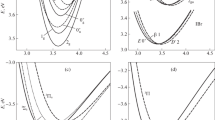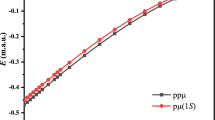Abstract.
A systematic investigation of the M+BF4 − (M = Li or NH4) ion-pair conformers has been carried out using an electrostatic docking model based on the molecular electrostatic potential topography of the free anion. This method provides a guideline for the subsequent ab initio molecular orbital calculations at the Hartree-Fock (HF) and second-order Møller-Plesset perturbation theory (MP2) levels. It has been demonstrated that the model presented here yields more than 75% of the HF interaction energy when Li+ is the cation involved and more than 90% for the case of NH4 +. Inclusion of MP2 correlation in the HF-optimized geometries leads to stationary point geometries with different numbers of imaginary frequencies and in some places where the energies of two adjacent conformers are very close, the energy rank order is altered. The HF lowest-energy minima for the Li+BF4 − and NH4 +BF4 − show a bidentate and tridentate coordinating cation, respectively, whereas at the MP2 level, this ordering is reversed.
Similar content being viewed by others
Author information
Authors and Affiliations
Additional information
Received: 9 September 1997 / Accepted: 5 November 1997
Rights and permissions
About this article
Cite this article
Suresh, C., Gadre, S. & Gejji, S. Theoretical studies on the structure of M+BF−4 ion pairs M = Li+, NH+4: the role of electrostatics and electron correlation. Theor Chem Acc 99, 151–157 (1998). https://doi.org/10.1007/s002140050317
Issue Date:
DOI: https://doi.org/10.1007/s002140050317




